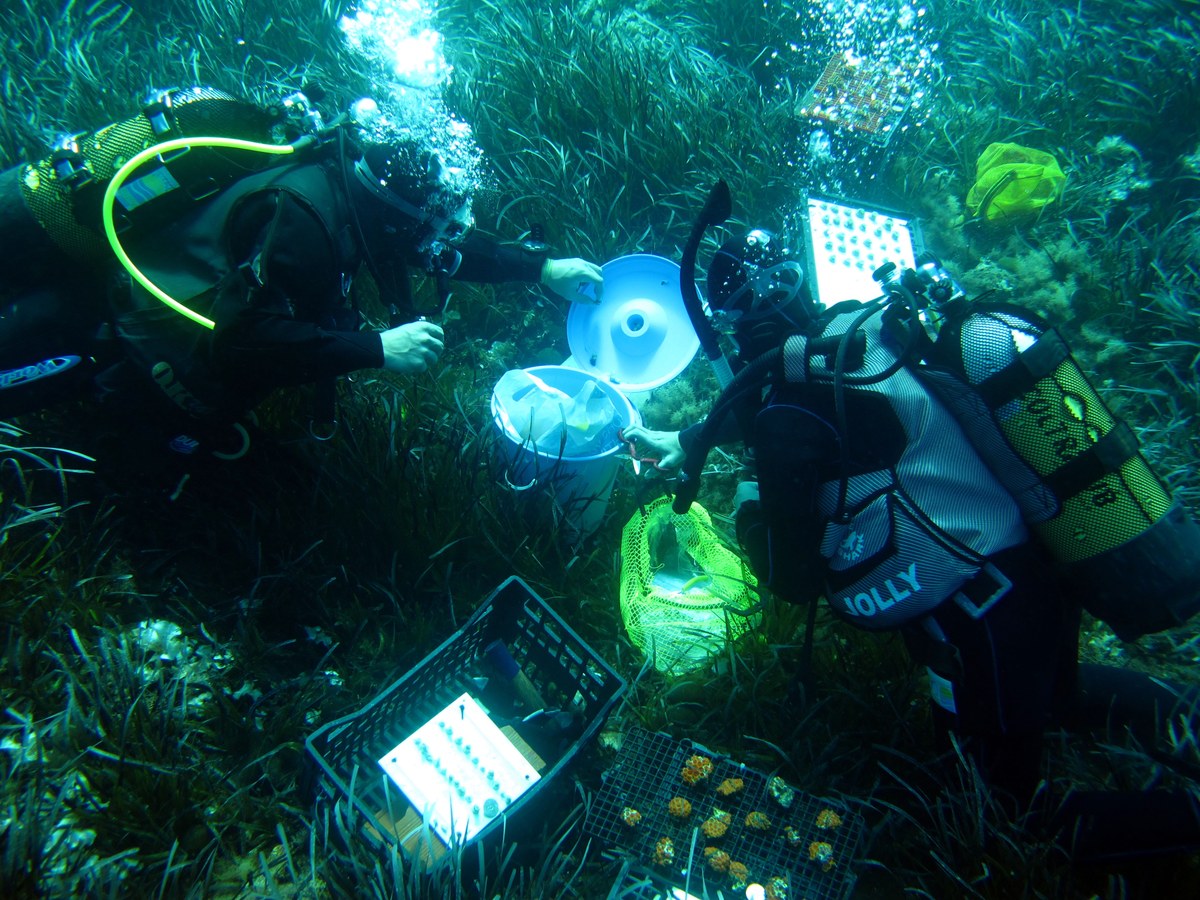Marine Science Group

Since 1997, Marine Science Group studies biology and ecology of temperate and tropical calcifying marine invertebrates (e.g. corals and molluscs) and vertebrates (e.g. fishes) in relation to climate change. Carbon dioxide enrichment responsible for ocean warming and acidification influences key processes of organisms that compose marine biodiversity, such as reproduction, calcification, photosynthesis, growth and population dynamics. Environmental effects on biological processes are studied through field, controlled (aquaria), and laboratory experiments. Scientific scuba diving is one of the main research tools used by Marine Science Group for data collection.
Since 1999, Marine Science Group is involved in Mediterranean and Red Sea marine biodiversity monitoring through volunteer involvement (citizen science). Collected data feed predictive models of climate change impact on marine biodiversity, which can be applied for management and conservation of natural resources.
Recently, the Marine Science Group is promoting environmental education programs based on the recreational aspect of tourism. The aim is increasing the environmental awareness of involved tourists.
The reproductive cycle of Mediterranean corals, which is regulated by seasonal variations in seawater temperature and photoperiod, is characterized through histological techniques, optical microscopy and image analysis software. Observations identify and quantify germ cells, thus delineating their maturation phases, fertilization period and embryogenesis that culminates with the planulation of new individuals. Analyses are performed in populations characterized by different environmental conditions to verify their influence on reproductive traits.
Macro-morphology of skeletons and shells of corals and molluscs is analyzed along the animal’s life cycle. Age can be determined through sclerochronology: the observation of annual growth bands that may be visible or require the application of radiologic techniques (e.g. computerized tomography). Organism growth rates are determined during their entire lifespan, through field measurements or mathematical models. By analyzing the demographic structure of studied populations, parameters such as mortality rate, mean age, and yield are determined. All these traits are compared among populations characterized by different environmental parameters.
Micro-morphology of skeleton and shells is studied in terms of porosity and density of calcium carbonate crystals that compose them. Porosimetry studies are performed through buoyant weight techniques and time domain nuclear magnetic resonance (TD-NMR), to obtain information on pore size distribution. Mechanical properties associated to different macro- and micro-morphology is investigated through instrumented nanoindentation techniques, thus measuring hardness (resistance to plastic deformation) and Young’s elastic modulus (response in a reversible deformation regime).
The process through which corals and molluscs produce skeletons and shells is called calcification and is regulated by an organic matrix that influences the organization of calcium carbonate crystals. To study this yet unclear process, analyses are performed on skeletons, shells and in vitro experiments. Through microscopic (SEM), infrared spectroscopic (FTIR), X-ray diffractometric (XRD), and thermogravimetric (TGA) analyses, the composition of biominerals is determined and embedded organic matrix is quantified. In vitro crytallization experiments are performed under different environmental conditions to determine the degree of biological control on the process.
The molecular mechanisms regulating the absorption of calcium carbonate by seawater, the formation of mineral crystals, and controlling the shape and structural properties of skeletons and shells are studied through next generation sequencing and real-time quantitative PCR techniques.
Self-fertilization rates are studied through molecular biology techniques on animal DNA microsatellite sequences, to assess genetic differences between adult individuals and their progeny. It is also possible to assess genetic variability and connectivity among populations.
Marine biodiversity monitoring is performed by involving volunteers (citizen science) in the collection of presence and abundance data of key marine species. Data collected by volunteers are compared with those collected by professional marine biologists to evaluate data quality. Data are subsequently elaborated to detect spatial and temporal trends on the status of monitored environments. Furthermore, the effectiveness of environmental education programs in improving tourists’ awareness and behaviour towards the environment is assessed.
National collaborations
Dott. Daniele Scarponi, BiGeA; Dott. Marco Stagioni, Laboratory of Marine Biology and Fisheries of Fano; Prof. Elena Fabbri, Dr. Silvia Franzellitti, Animal and Envrionmental Physiology, BiGeA; Prof. Marco Candela, Dr. Elena Biagi, Department of Pharmacy and Biotechnologies; Prof. Giuseppe Falini, Department of Chemistry <<Giacomo Ciamician>>; Prof. Paola Fantazzini, Dr. Leonardo Brizi, Department od Physics and Astronomy; Prof. Giulio Zanaroli, Department of Civil, Chemical, Environmental and Materials Engineering; Dott. Fabio Badalamenti, Dott. Paolo Montagna, Dott. Mauro Marini, Dott. Emanuela Frapiccini, National Research Council Ricerche; Dott. Nuria Teixido, Dr. Luigi Musco, Zoological Station Anton Dohrn Napoli.
International collaborations
Prof. Giacomo Bernardi (University of California, USA); Prof.ssa Monica Bullejos (University of Jaén, Spain); Prof. Nanette Chadwick (Auburn University, USA); Prof. Zvy Dubinsky (Bar Ilan University, Israel); Dott. Katharina Fabricius, (Australian Institute of Marine Science, Australia); Prof. Jaap Kaandorp, (University of Amsterdam, Netherlands); Prof. Todd C. LaJeunesse (Pennsylvania State University, USA); Prof. Howard Lasker, Prof. Mary Alice Coffroth, (State University of New York, USA); Dott. Tali Mass (University of Haifa, Israel); Dott. Baris Ozalp, (Canakkale Onsekiz Mart University, Turkey); Prof. Aldo Shemesh, (Weizmann Institute of Science, Israel); Dott. Alexis Terrón-Sigler, (Universidad de Sevilla); Prof. Christian Voolstra (King Abdullah University of Science and Technology, Saudi Arabia); Dott. Marlene Wall (GEOMAR Helmholtz Centre for Ocean Research Kiel, Germany).
Websites